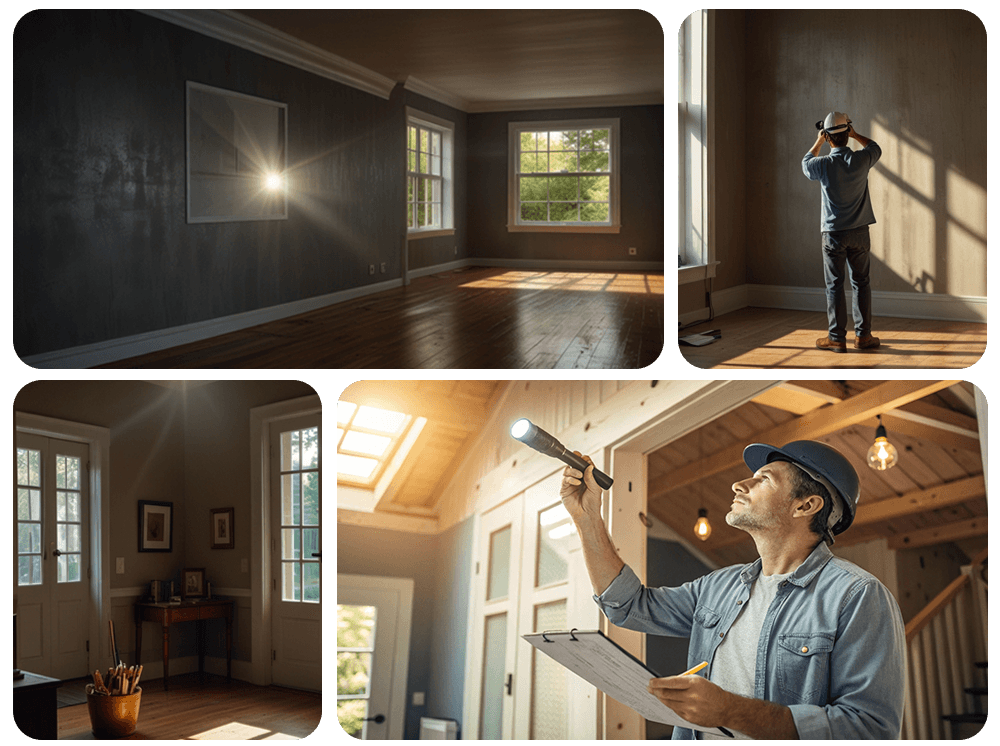For any prospective homebuyer, navigating the purchasing process involves numerous decisions, and one crucial element that should never be overlooked is the home inspection. A thorough home inspection plays a pivotal role in identifying potential issues within a property, providing buyers with a clear understanding of its condition before making a significant financial commitment. This step is essential, whether you're considering a newly-constructed home or a traditional, older property.
The concept of home inspections encompasses two primary types: new home inspections and traditional home inspections. New home inspections focus on recently constructed properties, scrutinizing aspects unique to new builds such as construction quality and adherence to modern building codes. Meanwhile, traditional home inspections apply to existing homes, where emphasis is placed on evaluating the property’s structural integrity and the condition of various systems that have been in use over time.
Comparing new and traditional home inspections highlights both distinctive challenges and benefits associated with each type. Understanding these differences enables potential buyers to make informed decisions and ensures that their chosen home meets both their standards and expectations.

Purchasing a newly built home is an exciting venture, promising the latest in design, technology, and construction standards. However, even brand-new properties warrant a comprehensive inspection to ensure their quality and longevity. New home inspections are specifically tailored to evaluate the unique aspects of recently constructed residences, focusing on areas critical to a home's performance and safety.
The cornerstone of a new home inspection is the assessment of construction quality. Inspectors meticulously evaluate whether the building is constructed according to the approved architectural plans and specifications. They ensure that the materials used meet industry standards and are installed correctly to prevent future issues. Attention is also paid to building code compliance. Although new homes should adhere to local regulations, inspectors verify that everything from electrical systems to plumbing installations meets the necessary codes and safety measures, providing peace of mind to prospective owners.
Finishing touches are another key focus of new home inspections. Inspectors look for cosmetic issues that might indicate larger underlying problems, such as cracks in walls or poor paint jobs, which could imply settling issues or foundational flaws. Slight imperfections can often hint at rushed construction practices.
Importantly, new build inspections also identify problems that are often overlooked, such as improper drainage or insufficient insulation. These elements are crucial for maintaining a comfortable living environment and ensuring energy efficiency. Poor drainage can lead to water damage and mold, while inadequate insulation can result in higher energy bills due to temperature fluctuations.
Pro Tip: Ensure your inspector checks for compliance with the latest energy codes and green building practices to maximize your new home's efficiency and sustainability.
Traditional home inspections are a critical step in purchasing an existing property, as they shed light on the condition and performance of a home that has weathered the test of time. The primary objective of these inspections is to provide a detailed report on the current state of the property, helping buyers identify potential issues that may require repairs or impact future maintenance costs.
One of the major focus areas of traditional home inspections is structural integrity. Inspectors evaluate the foundational elements of a home, looking for signs of deterioration or damage that could compromise stability. This includes assessing the condition of the foundation itself, as well as support structures like beams and joists. Understanding a property’s structural health is essential, as it impacts everything from safety to future resale value.
System wear and tear is another vital component of traditional home inspections. Homes become more susceptible to wear over time, impacting systems like plumbing, electrical, and HVAC. Inspectors meticulously examine each of these to reveal any existing damage or signs of aging. Plumbing issues, such as leaks or outdated piping, can lead to water damage and mold, while electrical hazards might include outdated wiring or overloaded circuits that increase the risk of fire.
Historical maintenance issues are also scrutinized during a traditional home inspection. Past neglect or improper repairs can cause more complex problems later. Inspectors look for evidence of ongoing issues, such as recurring roof leaks or persistent drainage problems, that could indicate a pattern of poor maintenance or unfinished fixes.
Particular attention is given to aging systems—plumbing, roofing, and electrical setups—due to their potential for costly repairs and replacements. For instance, an older roof may be more susceptible to leaks, while antiquated electrical systems might not support modern appliances safely. Addressing these concerns during the inspection phase allows buyers to negotiate necessary updates or adjustments in the purchase agreement.
Pro Tip: Request a detailed assessment of all major systems' expected lifespan from your inspector to help prioritize future maintenance or replacement plans.

When it comes to home inspections, the approach and focus can vary significantly between new and traditional home inspections, reflecting the distinct challenges and concerns associated with each type of property. One primary difference lies in the timelines and scheduling routines. New home inspections often occur in phases throughout the construction process, ensuring compliance and quality from foundation to finishing. In contrast, traditional home inspections typically happen as a comprehensive evaluation once the property is on the market, providing a complete overview of the existing condition of an older home.
In terms of issues identified during these inspections, new homes are more susceptible to settling problems. These occur as a building adjusts to its environment, potentially causing minor shifts and cracks. Inspectors of new homes pay special attention to identifying these early signs to ensure corrective measures can be taken if necessary, preventing further structural damage down the line.
On the other hand, traditional homes are more likely to display signs of long-term wear, such as system degradation and material fatigue. Inspectors focus on parts like the roof, plumbing, and electrical systems, looking for evidence of age-related wear and tear that might necessitate repairs or replacements. Understanding these issues helps buyers anticipate future maintenance or renovations, impacting decision-making and financial planning.
The content of inspection reports also diverges. For new homes, reports focus on whether the property meets all current building codes and identifies specific new build challenges, such as incorrectly finished surfaces or inadequate installations. They emphasize construction defects and compliance issues that could need immediate addressing. In contrast, inspection reports for traditional homes often highlight age-related concerns. They detail the condition of components that have been in use for years, advising on future repairs and ongoing maintenance needs to preserve the home's value and functionality.
Pro Tip: When reviewing your inspection report, consider consulting both your real estate agent and a trusted contractor to better understand any potential issues and negotiate effectively based on reliable expert input.
Home inspections, whether for new constructions or older homes, are indispensable components of the home-buying process. Despite their differing focuses, both types of inspections are crucial for ensuring that your investment is sound and your new residence is safe and habitable. A common misconception is that new homes, fresh out of construction, don't require as rigorous a check. However, even brand-new properties can harbor hidden defects that might not be immediately visible, such as improper installations or non-compliance with building codes. A thorough inspection can catch these issues early, preventing small oversights from turning into costly repairs later on.
Bypassing inspections poses significant risks for both new and existing homes. For new homes, skipping an inspection could mean missing vital construction errors that affect long-term structural integrity. In traditional homes, the absence of an inspection might allow age-related issues like outdated wiring or leaky plumbing to go unnoticed until they necessitate urgent attention, impacting safety and leading to potentially expensive repair bills.
Each type of inspection offers unique benefits that enhance the purchase decision. New home inspections offer peace of mind by ensuring that everything from foundation work to finishing touches meets the highest quality standards, confirming that the builder has adhered to all legal requirements and best practices. Conversely, traditional home inspections provide a detailed overview of the current state of the home's critical systems, helping buyers understand maintenance needs and future investment requirements. They offer a clear picture of both functional and cosmetic elements, empowering buyers to make informed decisions about potential pre-purchase repairs or post-purchase renovations.
Pro Tip: Regardless of the type of home you are purchasing, choose an inspector with experience relevant to your specific property type to ensure a comprehensive evaluation and insight into specialized issues that may arise.
To illustrate the value of thorough inspections, consider two compelling case studies—one focusing on a new home inspection and the other on a traditional home inspection. These real-world examples highlight the importance of having a comprehensive inspection, regardless of the property's age, and demonstrate the potential savings for buyers who invest in due diligence.
In the first case, a couple purchased a newly built home, excited to enjoy the state-of-the-art amenities and modern design. They wisely opted for a detailed inspection before finalizing the sale. The inspection revealed early construction flaws, including improperly sealed windows and doors that could lead to energy inefficiencies and water infiltration. Additionally, minor foundation settling was identified, which could have escalated into significant structural issues if not addressed promptly. Thanks to their vigilance, the couple was able to negotiate with the builder to rectify these problems before moving in, ensuring that their new home was both energy-efficient and structurally sound from the start.
The second success story involves a young family purchasing a charming century-old home. While the property boasted beautiful architecture and historic charm, it had been many years since a thorough evaluation of its systems was conducted. The traditional home inspection uncovered several critical updates needed, including an aging electrical system that posed safety risks and plumbing that required significant modernization to prevent future leaks and water damage. Equipped with this information, the buyers negotiated a substantial price reduction with the sellers, allocating the saved funds towards the necessary system upgrades, thus safeguarding their investment while preserving the home's historical allure.
Lessons learned from these scenarios underscore the integral role of inspections in the home-buying process. For new builds, inspections can catch and address construction issues early, preventing minor oversights from escalating into major defects. For older homes, inspections provide a roadmap for future maintenance and upgrades, ensuring the property remains safe and functional while respecting its original character.
Pro Tip: Use case studies as a learning tool to understand the types of issues that may arise with different property types and how previous buyers have successfully mitigated these challenges through effective inspection practices.
Home inspections, whether for new constructions or traditional homes, offer invaluable insights that safeguard your investment and ensure a smooth home-buying journey. Each type of inspection addresses unique issues—new home inspections focus on construction quality and compliance with current building codes, while traditional home inspections delve into the integrity and functionality of older systems and structures. Both provide a comprehensive evaluation that arms you with the knowledge needed to make informed decisions and negotiate effectively.
Regardless of the property's age or how pristine its condition may seem, skipping an inspection can lead to unexpected surprises and expenses down the road. Every home has its quirks and potential issues; professional inspections reveal these, allowing you to address them proactively. Don’t let the allure of a brand-new build or the charm of an older home blind you to the practical necessities of a thorough inspection.
Taking a proactive approach to home inspections ensures that you’re fully prepared to embark on your homeownership journey with confidence. For expert guidance and to schedule your specialized home inspection, contact 1stChoiceInspection today. Let us help you protect your investment and pave the way for a safe, comfortable living environment, free from hidden defects.